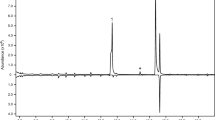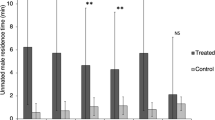Abstract
Pear psylla, Cacopsylla pyricola (Förster) (Hemiptera: Psyllidae), a major economic pest of pears, uses a female-produced sex attractant pheromone. We compared the chemical profiles obtained from cuticular extracts of diapausing and post-diapause winterform males and females to isolate and identify the pheromone. Post-diapause females produced significantly more of the cuticular hydrocarbon, 13-methylheptacosane, than post-diapause males and diapausing females. In olfactometer assays, conspecific males were attracted to synthetic racemic 13-methylheptacosane, whereas females were not, indicating that the behavioral response to this chemical is sex-specific. Furthermore, 13-methylheptacosane was as attractive to males as a cuticular extract of females, suggesting that this chemical was largely responsible for the female attractiveness. A field study showed that males but not females were attracted to 13-methylheptacosane, confirming the olfactometer results. This study provides evidence that 13-methylheptacosane is a sex attractant pheromone for C. pyricola winterform males. This is the first identification of a sex pheromone in the Psylloidea. Our results open the path to developing monitoring tools and possibly new strategies for integrated pest management of this insect.



Similar content being viewed by others
References
Benoit, J. B. and Denlinger, D. L. 2007. Suppression of water loss during adult diapause in the northern house mosquito, Culex pipiens. J. Exp. Biol. 210:217–226.
Brown, R. L., Landolt, P. J., Horton, D. R., and Zack, R. S. 2009. Attraction of Cacopsylla pyricola (Hemiptera: Psyllidae) to female psylla in pear orchards. Environ. Entomol. 38:815–822.
Burckhardt, D. 1994. Psylloid pests of temperate and subtropical crop and ornamental plants (Hemiptera, Psylloidea): A review. Trends Agric. Sci. Entomol. 2:173–186.
Carlson, D. A., Bernier, U. R., and Sutton, B. D. 1998. Elution patterns from capillary GC for methyl-branched hydrocarbons. J. Chem. Ecol. 24:1845–1865.
Do Nascimento, R. R., Jackson, B. D., Morgan, E. D., Clark, W. H., and Blom, P. E. 1993. Chemical secretions of two sympatric harvester ants, Pogonomyrmex salinus and Messor lobognathus. J. Chem. Ecol. 19:1993–2005.
Ginzel, M. D., Millar, J. G., and Hanks, L. M. 2003. (Z)-9-Pentacosene—contact sex pheromone of the locust borer, Megacyllene robiniae. Chemoecology 13:135–141.
Grula, J. W. and Taylor, O. R. Jr. 1979. The inheritance of pheromone production in the sulfur butterflies Colias eurytheme and C. philodice. Heredity 42:359–371.
Grula, J. W., McChesney, J. D., and Taylor, O. R. Jr. 1980. Aphrodisiac pheromones of the sulfur butterflies Colias eurytheme and C. philodice (Lepidoptera, Pieridae). J. Chem. Ecol. 6:241–256.
Guédot, C., Horton, D. R., and Landolt, P. J. 2009. Attraction of male winterform pear psylla to female-produced volatiles and to female extracts and evidence of male-male repellency. Entomol. Exp. Appl. 130:191–197.
Haverty, M. I., Grace, J. K., Nelson, L. J., and Yamamoto, R. T. 1996. Intercaste, intercolony, and temporal variation in cuticular hydrocarbons of Coptotermes formosanus Shiraki (Isoptera: Rhinotermitidae). J. Chem. Ecol. 22:1813–1834.
Hinkens, D. M., McElfresh, J. S., and Millar, J. G. 2001. Identification and synthesis of the sex pheromone of the vine mealybug, Planococcus ficus. Tetrahedron Lett. 42:1619–1621.
Horton, D. R., and Landolt, P. J. 2007. Attraction of male pear psylla, Cacopsylla pyricola, to female-infested pear shoots. Entomol. Exp. Appl. 123:177–183.
Horton, D. R., Broers, D. A., Hinojosa, T., and Lewis, T. M. 1998. Ovarian development in overwintering pear psylla, Cacopsylla pyricola (Homoptera: Psyllidae): seasonality and effects of photoperiod. Can. Entomol. 130:859–867.
Horton, D. R., Guédot, C., and Landolt, P. J. 2007. Diapause status of females affects attraction of male pear psylla, Cacopsylla pyricola, to volatiles from female-infested pear shoots. Entomol. Exp. Appl. 123:185–192.
Horton, D. R., Guédot, C., and Landolt, P. J. 2008. Attraction of male summerform pear psylla to volatiles from female pear psylla: effects of female age, mating status, and presence of host plant. Can. Entomol. 140:184–191.
Howard, R. W. 1993. Cuticular hydrocarbons and chemical communication, pp. 179–226 in D. W. Stanley-Samuelson, D. R. Nelson (eds.). Insects Lipids: Chemistry, Biochemistry and Biology. University of Nebraska Press, Lincoln.
Howard, R. W. and Blomquist, G. J. 1982. Chemical ecology and biochemistry of insect hydrocarbons. Annu. Rev. Entomol. 27:149–172.
Howard, R. W. and Blomquist, G. J. 2005. Ecological, behavioral, and biochemical aspects of insect hydrocarbons. Annu. Rev. Entomol. 50:371–393.
Jurenka, R. A., Holland, D., and Krafsur, E. S. 1998. Hydrocarbon profiles of diapausing and reproductive adult face flies (Musca autumnalis). Arch. Insect Biochem. Physiol. 37:206–214.
Krysan, J. L. and Higbee, B. S. 1990. Seasonality of mating and ovarian development in overwintering Cacopsylla pyricola (Homoptera: Psyllidae). Environ. Entomol. 19:544–550.
Lanier, G. N., Qi, Y. -T., West, J. R., Park, S. C., Webster, F. X., and Silverstein, R. M. 1989. Identification of the sex pheromone of three Matsucoccus pine bast scales. J. Chem. Ecol. 15:1645–1659.
Liepert, C. and Dettner, K. 1996. Role of cuticular hydrocarbons of aphid parasitoids in their relationship to aphid-attending ants. J. Chem. Ecol. 22:695–707.
Lockey, K. H. 1988. Lipids of the insect cuticle: Origin, composition, and function. Comp. Biochem. Physiol. 89B:595–645.
Marukawa, K., Takikawa, H., and Mori, K. 2001. Synthesis of the enantiomers of some methyl-branched cuticular hydrocarbons of the ant, Diacamma sp. Biosci. Biotechnol. Biochem. 65:305–314.
Nelson, D. R. 1978. Long-chain methyl-branched hydrocarbons: Occurrence, biosynthesis, and function, pp. 1–33, in J. E. Treherne (ed.). Advances in Insect Physiology Volume 13. Academic, London.
Nelson, D. R. 1993. Methyl-branched lipids in insects, pp. 271–315, in D. W. Stanley-Samuelson and D. R. Nelson (eds.). Insect lipids: Chemistry, Biochemistry and Biology. University of Nebraska Press, Lincoln.
Nelson, D. R., and Blomquist, G. J. 1995. Insect waxes, pp. 1–90, in: R. J. Hamilton (ed.), Waxes: Chemistry, Molecular Biology and Function. The Oily, Dundee.
Oldfield, G. N. 1970. Diapause and polymorphism in California populations of Psylla pyricola (Homoptera: Psyllidae). Ann. Entomol. Soc. Am. 63:180–184.
Pickett, J. A., Wadhams, L. J., and Woodcock, C. M. 1992. The chemical ecology of aphids. Annu. Rev. Entomol. 37:67–90.
Rodríguez, L. C., Faúndez, E. H., and Niemeyer, H. M. 2005. Mate searching in the scale insect, Dactylopius coccus (Hemiptera: Coccoidea: Dactylopiidae). Eur. J. Entomol. 102:305–306.
SAS Institute. 2002. SAS 9.1 for Windows. SAS Institute, Cary.
Singer, T. L. 1998. Role of hydrocarbons in the recognition systems of insects. Amer. Zool. 38:394–405.
Singer, T. L., Camann, M. A., and Espelie, K. E. 1992. Discriminant analysis of cuticular hydrocarbons of social wasp Polistes exclamans Viereck and surface hydrocarbons of its nest paper and pedicel. J. Chem. Ecol. 18:785–797.
Soroker, V., Talebaev, S., Harari, A. R., and Wesley, S. D. 2004. The role of chemical cues in host and mate location in the pear psylla Cacopsylla bidens (Homptera: Psyllidae). J. Insect Behav. 17:613–626.
Subchev, M., and Jurenka, R. A. 2001. Sex pheromone levels in pheromone glands and identification of the pheromone and hydrocarbons in the hemolymph of the moth Scoliopteryx libatrix L. (Lepidoptera: Noctuidae). Arch. Insect Biochem. Physiol. 47:35–43.
Wenninger, E. J., Stelinski, L. L., and Hall, D. G. 2008. Behavioral evidence for a female-produced sex attractant in Diaphorina citri Kuwayama (Hemiptera: Psyllidae). Entomol. Exp. Appl. 128:450–459.
Wong, T. T. Y., and Madsen, H. F. 1967. Laboratory and field studies on the seasonal forms of pear psylla in Northern California. J. Econ. Entomol. 60:163–168.
Yin, L. T., and Maschwitz, U. 1983. Sexual pheromone in the green house whitefly Trialeurodes vaporiariorum. Zeitsch. Angew. Entomol. 95:439–446.
Zar, J. H. 1999. Biostatistical Analysis, 4th edn. Prentice Hall, New Jersey.
Acknowledgments
We are grateful to Deb Broers and Merilee Bayer for conducting olfactometer and field assays and to Bonnie Ohler and J. Steven McElfresh for their assistance with the chemistry. We are also grateful to Erik Wenninger, David Hall, and two anonymous reviewers for their comments. This research was supported by Research Grant Award No. US-4048-07 from the United States - Israel Binational Agricultural Research and Development Fund (BARD), USDA-CSREES-NRI (2006-35302-17475), and the Washington Tree Fruit Research Commission (PR-05-504).
Author information
Authors and Affiliations
Corresponding author
Rights and permissions
About this article
Cite this article
Guédot, C., Millar, J.G., Horton, D.R. et al. Identification of a Sex Attractant Pheromone for Male Winterform Pear Psylla, Cacopsylla pyricola . J Chem Ecol 35, 1437–1447 (2009). https://doi.org/10.1007/s10886-009-9725-2
Received:
Revised:
Accepted:
Published:
Issue Date:
DOI: https://doi.org/10.1007/s10886-009-9725-2




